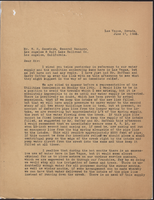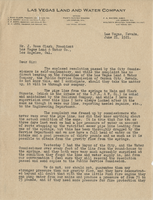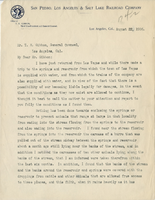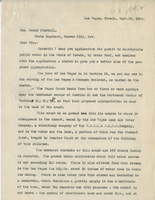Search the Special Collections and Archives Portal
Search Results

Letter to R. E. Wells, March 19, 1909
Date
Archival Collection
Description
Letter describing how the pipeline from the Springs should be replaced, and how something needed to be done about the low water pressure experienced by the town when filling trains.
Text

Letter from J. Ross Clark (Los Angeles) to W. H. Bancroft (Salt Lake City), July 21, 1909
Date
Archival Collection
Description
Clark recommends replacing the sheet metal pipeline with concrete to fix a massive leaking problem.
Text

Letter from Walter R. Bracken (Las Vegas) to W. H. Comstock (Los Angeles), June 17, 1922
Date
Archival Collection
Description
LVL&WC executives had been called to a meeting with the Utilities Commission about water shortages, and W. H. Comstock was seeing if they could quickly increase capacity before the meeting.
Text

Letter from Walter R. Bracken (Las Vegas) to J. P. Mack (Los Angeles), July 12, 1939
Date
Archival Collection
Description
Bracken was asking the Las Vegas Land and Water Company to disallow payment to the person who should have repaired the leaking pipeline but didn't. The spraying pipeline severely hampered their credibility in the public eye when asking for conservation from citizens.
Text

Letter from Walter R. Bracken (Las Vegas) to F. R. McNamee (Los Angeles), November 20, 1912
Date
Archival Collection
Description
Workers installing sewer lines disturbed the water mains, which would cause many future problems, and Bracken was asking the company lawyer how to proceed.
Text

Letter from Walter R. Bracken (Las Vegas) to J. Ross Clark (Los Angeles), December 11, 1919
Date
Archival Collection
Description
Bracken informing Clark of the steps he had taken to prepare the railroad and the city of Las Vegas for the 24 hours without water that would be required to fix the damaged pipeline.
Text

Letter from Walter R. Bracken (Las Vegas) to W. H. Comstock (Los Angeles), May 23, 1920
Date
Archival Collection
Description
Two hotels complained that they had no water pressure on their second floors, and Bracken discussed the possibility of purchasing a well to boost the pressure in the system.
Text

Letter from Walter R. Bracken (Las Vegas) to J. Ross Clark (Los Angeles), June 21, 1921
Date
Archival Collection
Description
Bracken appraising Clark of a complaint by the City Commission to the Nevada Public Service Commission and its resolution.
Text

Letter from C. O. Whittemore (Los Angeles) to T. E. Gibbon (Los Angeles), August 22, 1906
Date
Archival Collection
Description
Whittemore stating that the reservoir at the Las Vegas Springs should be covered and a pipeline run since the open water system was an epidemic and a lawsuit waiting to happen.
Text

Letter from M. S. Beal (Las Vegas) to Henry Thurtell (Carson City, Nevada), September 25, 1906
Date
Archival Collection
Description
Lawyer notifying the state engineer that Peter Buol had applied for some water from the Las Vegas Creek, which entire length and the springs were on land owned by the railroad on the basis that some of the water was wasted and therefore available.
Text
